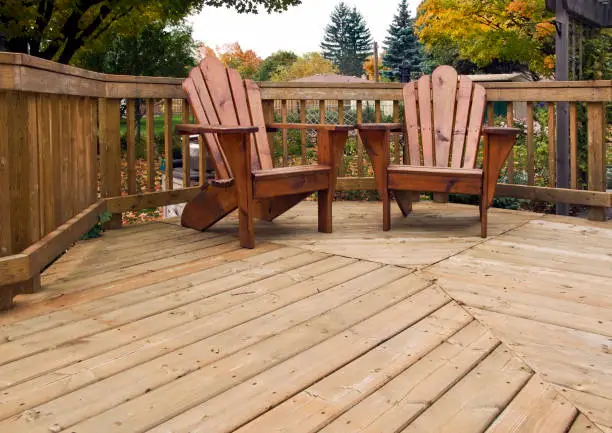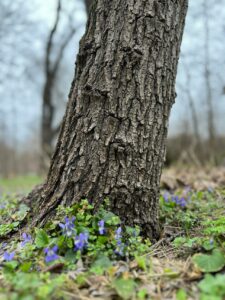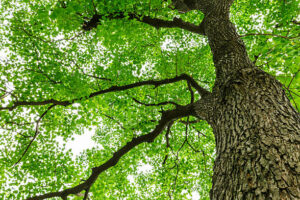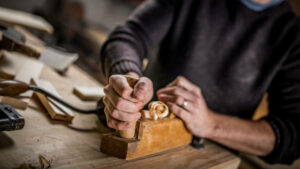Whether it’s a timeless wooden deck, garden furniture, or redwood pergola, treated wood adds organic beauty and functionality to outdoor spaces. Preserving the protective qualities and natural allure of these wooden installations involves a combination of understanding the nature of untreated pressure-treated wood throughout, selecting the right treatment, and implementing consistent maintenance practices. In this article we will be discussing how to treat untreated wood for outdoor use.
Choosing the Right Treatment
Untreated woods have an alluring charm that bolsters the aesthetic of any outdoor space. Unlike treated lumber, which often requires preservatives and other chemicals, untainted planks feature a unique beauty that is accentuated by the distinct grain patterns present in each piece of unfinished wood. Popular untainted choices include cedar, teak, pine, and redwood, all of which possess inherent properties that make them a favorite among wood furniture and design enthusiasts.
However, unless protected and cared for properly, untreated wood can become vulnerable to rot and decay if exposed to prevailing environmental stressors. That’s why it’s important to invest in a preservative system that will effectively shield wood fibers and natural wood from abrasions, moisture, and UV radiation.
Sealants and stains are effective and highly versatile options for protecting untreated wood for outdoor use. These products form a protective barrier, shielding the exterior wood part from infiltration of moisture and inhibiting fungal growth. Additionally, they offer a range of color options for enhancing the wood’s appearance.
When choosing a treatment, it’s essential to consider the specific requirements of the wood species, prevailing environmental conditions, and desired visual outcomes. Ensure the treatment is safe for the wood species you intend to treat and follow application instructions carefully to ensure optimal performance.
In addition to a preservative system, routine inspection of the wood should be conducted to identify and address any signs of damage or wear. This will prevent minor concerns from escalating into major problems, and it will also help prolong the lifespan of the wood.
If you’re interested in an environmentally friendly and non-toxic alternative to traditional pressure-treated lumber, borates may be the ideal option for you. These compounds are derived from naturally occurring minerals found in rocks, water, and living organisms. Unlike preservatives, borates do not leach into groundwater sources and are therefore safer for humans and the environment. Additionally, borates can be used for indoor projects without the risk of toxicity. However, it’s important to note that borates do not protect wood from the effects of direct sunlight or prolonged moisture exposure. As such, it’s important to cover any outdoor wooden structures with a tarp or covering when not in use.
Preparing the Wood
Untreated wood has an intrinsic beauty and authenticity that makes it a popular choice for outdoor projects, such as decks, furniture, and pergolas. However, it is important to understand that it is also extremely vulnerable to moisture and environmental stressors, which can quickly compromise its structural integrity and visual allure over time. Incorporating proactive preservation strategies into your care routines can mitigate these challenges, allowing your wood to retain its resilience quality lumber, and visual allure for as long as possible.
Whether you choose to treat your wood with a sealant, preservative, or stain, the first step is always thorough cleaning. By removing dirt, debris, and previous coatings before treating wood, you create a clean and receptive surface that will ensure the chosen treatment is applied evenly and effectively.
Wood stains and preservatives protect your wood against moisture, fungal decay, and insect damage by penetrating the fibers of the wood. While some species, such as teak and cedar, are naturally resistant to these threats, others, such as pine and hemlock, require special protection to keep them safe from the elements.
Waterproofing sealants are another popular way to safeguard your wood from moisture, preventing the formation of mold and mildew, as well as prolonging the lifespan of your outdoor wooden installations. Sealants are available in a wide range of finishes, from clear to semi-transparent plastic, allowing you to achieve the desired aesthetic for your project.
Epoxy is an effective and durable sealant and paint that is formulated for use on indoor and outdoor projects. However, you must be sure to select an epoxy product that is rated for outdoor use. This ensures that the coating can withstand exposure to UV rays, and will not yellow over time.
When applying your chosen treatment, follow the manufacturer’s instructions closely for application tools, safety precautions, and environmental conditions. Apply multiple coats of the product, ensuring that all areas are properly covered and protected, especially joints and end grains. Allow each coat to dry fully before applying the next, as directed by the product’s manufacturer. Regular maintenance with reapplication as needed can further prolong the life of your outdoor wooden installations.
Applying the Treatment
Untreated wood carries a raw and organic charm that accentuates the natural beauty of outdoor settings. However, without appropriate protection, it is susceptible to a wide range of challenges that can compromise its structural integrity and visual appeal over time. This includes moisture-related issues like swelling, warping, and rot, as well as insect infestation and harsh weather conditions that can lead to discoloration and surface degradation.
To avoid these problems, it’s important to follow the steps outlined in this guide when using untreated wood outdoors. From proper cleaning, sanding, and surface preparation, to selecting the right treatment and applying it effectively, each step plays a vital role in safeguarding wood from moisture and other damaging factors. By incorporating these preservation practices into an ongoing maintenance routine, individuals can uphold the resilience and visual allure of their outdoor wood furniture and structures for years to come.
The specific type of lumber used for a given project is a major factor that influences the lifespan of untreated wood. Some species are naturally more resistant to rot and insect damage than others, such as cedar or redwood. In addition, it is also important to ensure that the untreated lumber is kiln-dried before use. This process helps to remove excess moisture, which makes the wood less vulnerable to rotting and insects.
Once the wood has been cleaned and sanded, it should be treated with a water-repellent sealant or outdoor wood oil. Depending on the porosity of the wood, multiple coats of wood sealer may be necessary to achieve optimal protection. It is also crucial to apply the treatment evenly across the entire surface, paying special attention to joints, end grain areas, and other vulnerable spots.
Finally, it is important to cover or wrap wooden furniture and structures when not in use to reduce prolonged exposure to harsh elements. Doing so can help to protect against UV radiation, moisture, and temperature fluctuations that can impact the lifespan of the wood. Regular inspections and reapplication of the treatment will ensure that untreated wood continues to provide a durable shield against the elements, preserving its structural integrity and visual appeal for years to come.
Maintenance
The key to safeguarding untreated wood against environmental stressors is consistent and proactive maintenance. Taking a variety of measures to treat wood well, such as applying a water-repellent preservative, using protective covers for outdoor furniture or structures, and maintaining a regular wood staining schedule, can help protect the structural integrity and aesthetic beauty of natural wood, extending its lifespan and durability in outdoor settings.
Although some types of untreated wood are naturally rot-resistant, such as cedar and redwood, most species deteriorate rapidly when left unprotected. This deterioration is caused by exposure to moisture, soil, and fungus, which can lead to rot, mold growth, and other problems. Properly protecting untreated wood against the elements can significantly extend its life and minimize rot, mold, and mildew growth.
One of the most important things to do to protect untreated wood is to keep it out of direct sunlight, as prolonged exposure can lead to fading and discoloration. In addition, the sun’s UV (ultraviolet) rays can degrade the lignin in wood, which can cause it to become more brittle.
To prevent the deterioration of untreated wood, it is essential to treat it with a water-repellent preservative or sealer that includes UV protection. Preparing the wood properly by removing all dirt, debris, and other foreign materials can also increase the effectiveness of the treatment, as it will provide hardwood with a smooth and receptive surface for the preservative or sealant to bond with.
Other steps that can be taken to extend the lifespan of untreated wood include minimizing exposure to rain and fluctuating temperatures and cleaning the surface regularly to remove dirt and dust. Additionally, it is a good idea to elevate wood products off the ground, as this can help reduce the likelihood of rot and other moisture-related issues.
Untreated wood has a unique aesthetic that celebrates the natural beauty of its grain and structure. However, it is susceptible to a range of environmental stresses that can compromise its longevity and appearance over time. Understanding these vulnerabilities, selecting the appropriate treatment, and implementing proper maintenance practices can help uphold the protective properties and visual appeal of untreated wood in outdoor environments.






